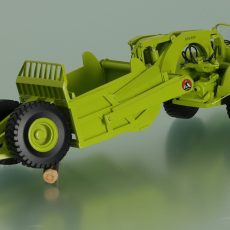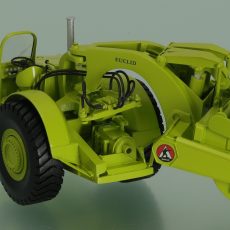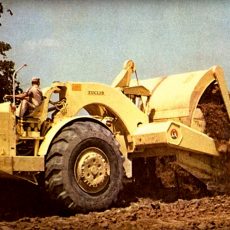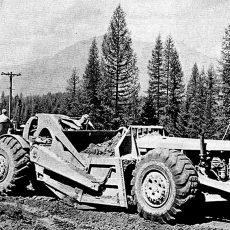Euclid S-18, 30LOT-31SH, motor scrapers

Euclid S-18, 30LOT-31SH, motor scrapers, capacity 23 cubic yards struck and 32 heaped, payload capacity 35 tons, operating weight 31.25 tons empty, 62 tons loaded, 325-horsepower GM Diesel 6-110 engine, top speed 28.7 mph, 12 units, Manufactured in the USA, UK, excess of 1000 machines in 1954-61.
Описание оригинала

Photo Eric C. Orlemann.
https://contractormag.co.nz/classic-machines/euclid-s-18/
RICHARD CAMPBELL admits that the Euclid S-18 is in his ‘top 10’ list of favourite motor scrapers, having spent more hours than he cares to remember on or around them.
First introduced in 1954 the Euclid S-18 was produced in two distinct versions. A classic example of a scraper that looked ‘right’ for the job, the S-18 was a massive brute of a machine powered by a General Motors 6-110, 6-cylinder inline supercharged diesel, initially rated at 300 horsepower. This was raised to 336 horsepower not long after the machine was put into full scale production
Coupled to the GM 6-110 was an Allison CLT5640, 4-speed, powershift transmission with torque converter. The transmission featured lockup in second through to fourth gears, and a loaded S-18 on a good haul road could reach speeds of almost 30 miles per hour.
Fully hydraulic in operation, the S-18 introduced a newly designed two-cylinder steering system – a design that became standard for Euclid overhung scrapers for years to come.
With unobstructed 90 degree right and left power steering, the S-18 had a turning circle of around 36 feet, very respectable for a big scraper of the time.
For its era the Euclid S-18 was well appointed for the operator. All of the controls were within easy reach and required little effort to use. Visibility was good and a full set of easily read gauges were fitted. A solid and well padded pedestal type seat was standard, but a Milsco air suspension unit was an option. The S-18 also rode well either empty or loaded.
When well maintained, the S-cam air operated brakes provided good stopping ability.
The bowl (in its initial form) had a capacity of 18 cubic yards struck and 24 cubic yards heaped. However, following a redesign in 1956, the capacity was increased to 21 cubic yards struck and 30 cubic yards heaped.
Operation was by the now-familiar Euclid cylinder and lever arrangement. Hinged behind the bowl’s cutting edge, the floor was tilted up and forward to eject the load via a three-stage, single-acting hydraulic cylinder.
A conventional hitch connected the tractor to the scraper and permitted lateral oscillation of 20 degrees each way to facilitate movement over uneven ground.
Production of the S-18 was also undertaken at the Euclid plant in Scotland commencing in 1959. While externally almost identical to their American-built cousins, for some reason, the UK-produced examples were powered by a 320 horsepower Cummins NRTO-6 turbocharged diesel. The design of the scrapers spillguard also differed from US production and the machines had Simms electrical systems instead of American Delco.
The S-18 was dropped from Euclid’s product range in 1961 and was replaced by the new and more powerful S-24.
Total production of all variants, including UK machines, was in excess of 1000 machines.
The NZ Connection
A total of three S-18s were imported by Euclid dealer Clyde Engineering – two from American and one from British production.
Taylor & Culley and OF Howey were the original owners of the US built machines, and Collis & Herron had the British built unit for a short time. It was later sold to Taylor & Culley.
Two of the machines were imported with factory fitted cabs and the UK-built machine came into the country on 27.00 x 33 tyres (the US examples had wide-base 33.5 x 25s).
The Howey machine spent most of its life on South Island hydro work while Taylor & Culley’s first unit went to work on the Wellington Airport job at Rongotai.
The Collis & Heron machine was used for a short period in Ohai, Southland before migrating to the North Island where it was employed in roading and civil construction.
This machine was eventually converted into a water tanker and re-exported to the South Island for use at Twizel where it was written off after an accident.
Your writer operated both the US and UK machines on subdivision work in Kelson in the Hutt Valley and also on the first stage of the Mangaweka Deviation in the central North Island. They were a reliable and honest tool with few vices, and a pleasure to operate.
Brief Specifications – Euclid S-18 (US production)
Engine: General Motors 6-110 diesel, 336 hp
Transmission: Allison CLT5640, 4-speed powershift
Top Speed: 28.7 mph
Steering: Euclid, full hydraulic, twin cylinder
Turning Circle: 36’
Brakes: Air operated ‘S’-cam shoes on all four wheels
Std.Tire: 27.00 x 33, optional 33.5 x 25
Capacity: 21 cubic yards struck, 30 cubic yards heaped
Operation: Full hydraulic
Ejection: Roll out
Length: 41’ 2”
Width: 11’ 7”
Height: 11’
Operating Weight: 31.25 tons empty, 62 tons loaded






















